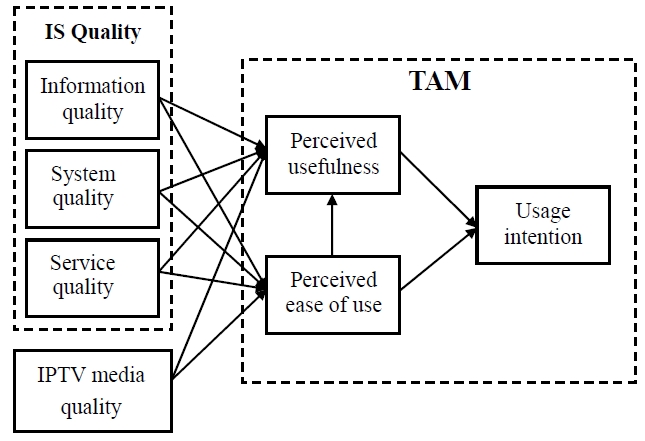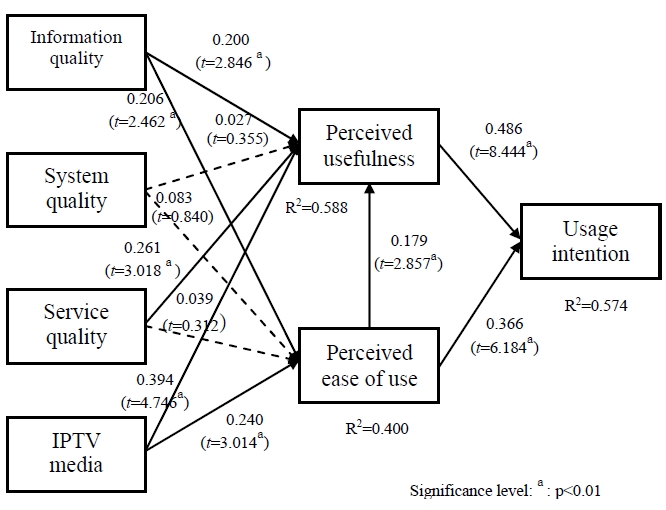



Recently, internet protocol television (IPTV) has emerged as a new broadcast medium, following terrestrial, satellite, and cable broadcast networks, and has become a basis for the convergence of broadcasting and communications based on Web 2.0. IPTV, unlike traditional broadcast media, generally faces no bandwidth limitations, which allows it to offer large numbers of channels.
Given the rapidly increasing number of IPTV subscribers and the expansion of the IPTV market, there has been growing research interest in IPTV. A number of studies have examined customer satisfaction and usage intention with respect to IPTV services. In addition, some studies have analyzed the effects of government policies on the acceptance of IPTV, and others have examined the activation of IPTV services. These studies have typically focused on the quality of IPTV services, and thus, little is known about the media properties of IPTV.
The objective of the present study is to identify the factors that motivate users to adopt IPTV, including information quality, system quality, and service quality. In addition, the study examines the effects of these factors and media quality on perceived usefulness, perceived ease of use, and usage intention with respect to IPTV services. For this, the study employs Davis's technology acceptance model (TAM) and DeLone and McLean's model of information systems success.
IPTV is an internet-based TV service providing all the services of traditional media (e.g., data, videos, songs, and TV programs) through the internet protocol.
The International Telecommunication Union defined IPTV as
>
B. Technical Acceptance Model
The TAM, an information system (IS) framework proposed by Davis [1], is one of the most influential extensions of Ajzen and Fishbein’s [2] theory of reasoned action (TRA). TAM replaces many of the TRA’s attitude measures with two technology acceptance measures: ease of use and usefulness.
Davis et al. [3] proposed perceived usefulness and perceived ease of use as important prerequisites for inducing the actual use of computer systems and defined perceived usefulness as “the degree to which a person believes that using a particular system would enhance his or her job performance” and perceived ease of use as “the degree to which a person believes that using a particular system would be free from effort.” A number of studies have examined and expanded TAM, and thus perceived usefulness and perceived ease of use are well known to be important explanatory variables for information technology acceptance.
>
C. Information System Quality
With the development of information technology, previous studies have examined IS quality from various perspectives.
DeLone and McLean’s [4] seminal study of IS quality provided the key factors in IS success. According to their model of information system success, IS quality includes system quality, information quality, and service quality, and these factors have considerable influence on usage intention, user satisfaction, and the total effect (net income).
The uses and gratifications theory of Katz et al. [5] is a popular framework for understanding mass communication [6, 7].
This theory focuses more on consumers or audiences than on actual messages by asking “what people do with media,” not “what media does to people” and suggests that people’s needs influence what media they choose, how they use certain media, and what gratification they find in media. First, audiences are conceived as active participants, i.e., an important part of mass media use is assumed to be goal-oriented. Second, media compete with other sources of customer satisfaction. Third, people are sufficiently self-aware and are thus able to verbally report their interests and motives in particular cases (or at least to recognize them) when confronted with them in an intelligent and familiar manner. Fourth, value judgments about the cultural importance of mass communication should be suspended while the audience’s orientation is explored on their own terms.
III. RESEARCH MODEL AND HYPOTHESES
This study examines the effects of IS quality and media quality on the intention to use IPTV. For this, the study proposes a research model based on Davis’s TAM and DeLone and McLean's model of IS success.
The model of IS success includes information quality, system quality, and service quality and is used to measure quality of IS services. Following previous research, this study considers media quality as a variable for IPTV attributes. The study also explores the relationships between IPTV service quality attributes and the TAM model. Fig. 1 illustrates the research model.
To identify the factors influencing IPTV usage intention, this study uses Davis's TAM and DeLone and McLean's model of IS success. In addition, this study investigates the effects of IS quality and media quality on IPTV use in terms of perceived usefulness, perceived ease of use, and usage intention [8, 9]. In this regard, we propose the following hypotheses:
H1.1: Information quality has a positive effect on perceived usefulness.
H1.2: Information quality has a positive effect on perceived ease of use.
H2.1: System quality has a positive effect on perceived usefulness.
H2.2: System quality has a positive effect on perceived ease of use.
H3.1: Service quality has a positive effect on perceived usefulness.
H3.2: Service quality has a positive effect on perceived ease of use.
H4.1: Media quality has a positive effect on perceived usefulness.
H4.2: Media quality has a positive effect on perceived ease of use.
H5: Perceived ease of use has a positive effect on perceived usefulness.
H6: Perceived usefulness has a positive effect on usage intention.
H7: Perceived ease of use has a positive effect on usage intention.
IV. RESULTS OF EMPIRICAL ANALYSIS
For the determination of factors influencing IPTV use, users with IPTV experience were selected for the survey. The questionnaire items, which were based on previous research, were modified by professionals (headquarters, technical and sales staff members at Korea Telecom (KT), a major IPTV service provider in Korea) with knowledge of IPTV systems. For the reliability and validity of the questionnaire items, a pretest was conducted with 32 individuals who used IPTV services for at least six months.
Of the 300 questionnaires distributed, 252 were returned. However, 30 were incomplete or lacked a sufficient understanding of IPTV services, and thus, they were excluded, resulting in a total of 222 respondents.
Among the 222 respondents, 129 (58.1%) were males; approximately 60% were in their twenties and thirties; 63 (28.4%) were students; and the majority (63.5%) of respondents had a bachelor’s degree. Among the representative IPTV operators in Korea (KT, SK Broadband, and LG Telecom), most respondents (56.3%) used KT. In addition, approximately 74% used IPTV for less than 6 months. Table 1 profiles the respondents.
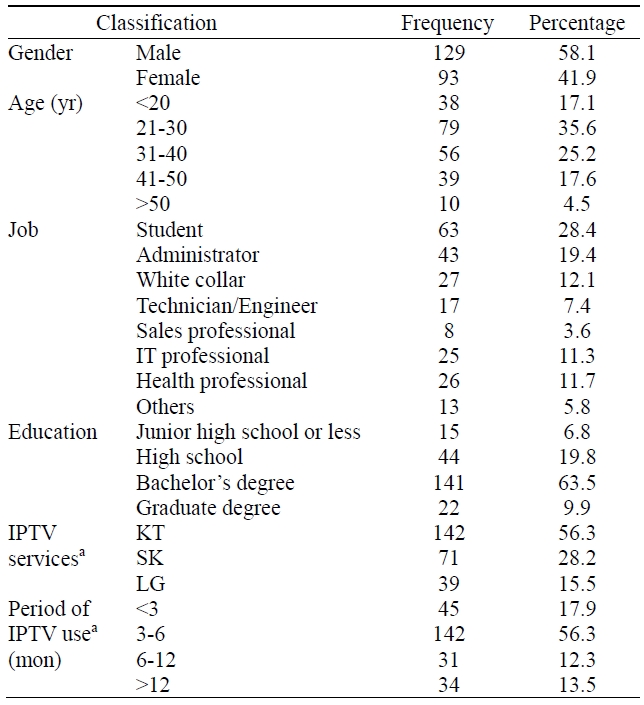
Respondents
>
B. Reliability and Validity of Measurement Model
We used SmartPLS 2.0 (Hamburg, Germany) to test the hypotheses. We assessed the measurement model using partial least squares (PLS) by considering item loadings, internal consistency, and discriminant validity. We measured item loadings from constructs and t-values by using the bootstrap procedure of PLS as a test of convergent validity.
As shown in Table 2,we analyzed the measurement items for their reliability and validity. In terms of their reliability, Cronbach's α exceeded 0.7 (the common threshold value) for all the items.
To validate the reliability and validity between the constructs, we calculated the credibility concept internal consistency reliability (ICR) and average variance extracted (AVE) values and conducted correlation analyses. The concept of reliability exceeded 0.7 (the reference value) for all the variables.
The loadings ranged from 0.607 to 0.911, and the AVE values exceeded the acceptable value of 0.5. As summarized in Table 2, the results established the reliability and validity of all the items.
[Table 2.] Reliability and validity analysis
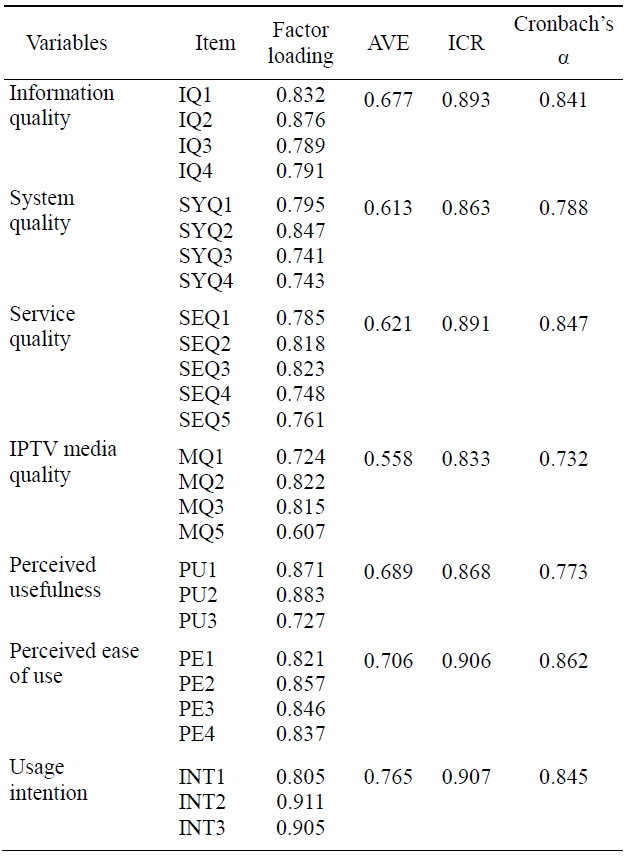
Reliability and validity analysis
We conducted a correlation analysis to examine the relationship between each pair of variables. In addition, we conducted a multivariate analysis to measure the multicollinearity between the independent variables.
Table 3 shows the correlations between variables. The diagonal values represent the square root of AVE values. Yi and Davis [10] suggested that the square root of the AVE value should exceed 0.707 and be higher than other correlation coefficients. All AVE values exceeded 0.5 and other correlation coefficients. Hence, the results indicate sufficient discriminant validity.
[Table 3.] Correlation analysis
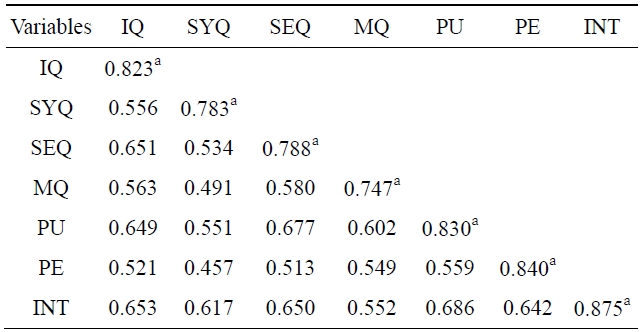
Correlation analysis
We tested each hypothesis by using a PLS Graph and examining the path coefficients. The estimated path effects, together with their level of significance, are given. Fig. 2 shows the structural equation model (SEM) results (dotted lines indicate non-significant paths) and standardized path coefficients between constructs [11].
First, consistent with previous research, information quality was positively related to perceived ease of use (path = 0.200, t = 2.846) and perceived usefulness (path = 0.206, t = 2.462), providing support for H1.1 and H1.2 and indicating the importance of providing IPTV users with accurate information.
Second, system quality did not have significant effects on perceived ease of use or perceived usefulness, providing no support for H2.1 (path = 0.027, t = 0.355) or H2.2 (path = 0.083, t = 0.840). Lin and Lu [12] found that system quality has a significant effect on perceived usefulness and ease of use, but recent studies have suggested that system quality has no significant effect on users’ intention to repurchase IPTV service. This indicates that system quality (e.g., VOD loading speed, real-time cross-channel speed, and privacy) may not meet users’ expectations.
Third, service quality had a significant positive effect on perceived usefulness (path = 0.261, t = 3.018), which is consistent with the findings of previous studies, but not on perceived ease of use (path = 0.039, t = 0.312), providing support for H3.1 but not for H3.2. These results indicate that service quality can easily satisfy the objectives of IPTV users but that the actual use of IPTV requires a great deal of effort.
Fourth, media quality had positive effects on perceived ease of use and perceived usefulness, providing support for H4.1 (path = 0.394, t = 4.746) and H4.2 (path = 0.240, t = 3.014). This indicates that the media characteristics of IPTV (e.g., its interactivity, content, and multitasking capability) can meet IPTV users’ objectives and foster user-friendly conditions.
Finally, we tested the relationship between the TAM variables. Perceived ease of use had a significant positive effect on perceived usefulness (path = 0.179, t = 2.857), providing support for H5. Perceived usefulness and perceived ease of use had significant positive effects on usage intention, providing support for H6 (path = 0.486, t = 8.444) and H7 (path = 0.366, t = 6.184). Table 4 summarizes the results.
[Table 4.] Hypothesis test results
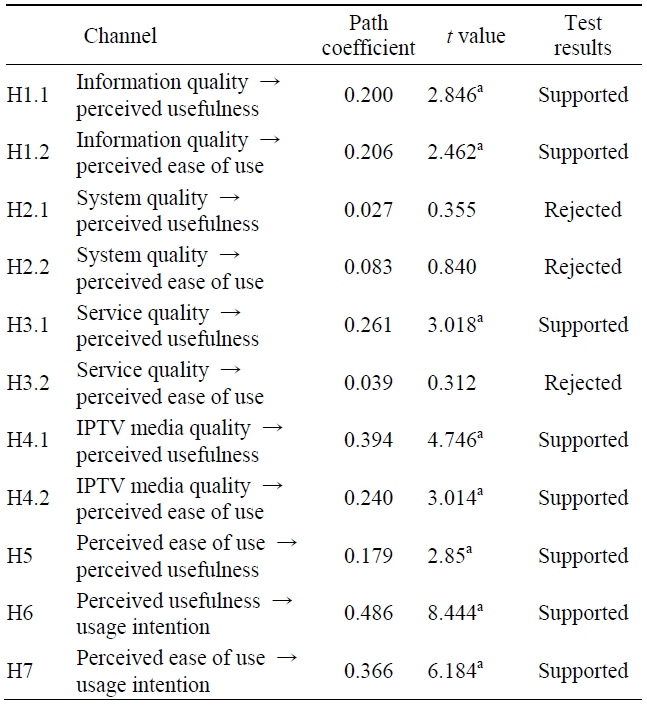
Hypothesis test results
We examined the factors influencing IPTV use by employing Davis's TAM and DeLone and McLean's model of IS success, which are widely used in IS research. Based on these models, we considered a research model including media quality, and with a sample of 222 IPTV users, we tested a set of hypotheses about IPTV use. The results are summarized as follows.
First, information quality, service quality, and media quality had significant effects on perceived usefulness, but system quality had no such effect on perceived usefulness. Second, information quality and media quality had significant effects on perceived ease of use, but system quality and service quality did not influence perceived ease of use. Third, perceived ease of use influenced perceived usefulness, and perceived usefulness and perceived ease of use influenced usage intention. These results indicate that the stability and reliability of IPTV services can induce IPTV use and that high media quality can facilitate IPTV success.
>
B. Implications and Limitations
The results have a number of important implications. First, we examined the factors influencing IPTV use by combining the media attributes of IPTV with Davis's TAM and DeLone and McLean's model of IS success. Second, media quality was most likely to influence perceived usefulness and perceived ease of use. Unlike traditional media, IPTV is based on a wide range of new and unique elements, particularly in terms of its interactivity, content diversity, ease of use, and multitasking capability. Therefore, IPTV service providers should pursue aggressive customization.
Third, information quality had a positive effect on perceived usefulness and perceived ease of use, suggesting that IPTV service providers should continuously update their content and provide accurate information to ensure customer satisfaction. Finally, service quality had a significant effect on perceived usefulness. Thus, IPTV providers should provide reliable after-sales as well as before-sales service and facilitate collaboration between relevant departments (e.g., sales and technical support) to provide informal and technical aspects based on prompt service and appropriate expertise.
This study has some limitations. First, IPTV systems were studied using only DeLone and McLean’s [13] variables and IPTV media quality with external variables. In this regard, future research should examine the relationship between the characteristics of potential users of IPTV and their acceptance of IPTV. Second, system quality had no significant effects on perceived usefulness and perceived ease of use, which indicates a need for developing items that could better reflect the attributes of IPTV system quality. Third, for more practical strategies for inducing IPTV use, future research should emphasize the strategic aspects of study.
